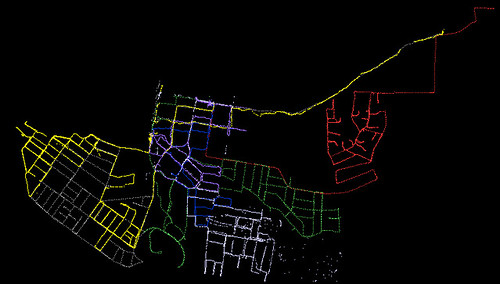Its been a little while… Holidays and all that, but at least a tiny bit of Portugal is now mapped, and I’ve found out conclusively that my kids don’t find it amusing anymore to drive twice round a roundabout!
The Essen developers Workshop has been and gone (it has been a while!). A great weekend by the sound of it – pick up the results here – and if you wondered what happened to the code in subversion, a big restructuring (for the better!) happened. The code’s still there, but more logically laid out. It will be interesting to see what will come out of the UK workshop in Oxford next weekend.

Its been a good week for the osmarender layer on coastlines, again brought up at the Essen workshop. The threads Blue sea tiles, speckled oceans, & too much blue give an indication. So, thanks to Frederick’s work on a pre-processor to handle colouring of coastline tiles the coast is looking rather spiffing. Its great that (I guess) everyone who lives near the coast or had an interest in a bit of coastline made sure the coastline ways were fixed for their area (I know I did!). In fact its been such a good week for osmarender that there was a suggestion to create a separate osmarender-dev mailing list for it!
With a nod to Shakespeare, the thread titled: Users, contributors and developers, (… I come to bury columns; not to praise them) is worth a read in that it covers some of the ethos of OSM and how the simple approach to mapping is working very well. It then goes on to discuss the idea of a ‘third column’ to give namespaces to attributes that was brought up at the Essen workshop.
Watch out for The Rails Port of the server/API coming to a machine near you real soon! Announced by Nick Black on dev. This is going to have a big impact on OSM pretty quickly as its going to make it much easier for the devvers to tinker quickly in a safe environment.

Everyone loves animations!?! Dave has been making snapshots of progress on London over the last 6 months. You’ll have to follow the link to go to the animation.
Placenames disappearing! Its been discussed for a while, but David Earl noticed as you zoom in the slippy map that different names appear and disappear. Its a general problem with what to render at different levels, but it is an interesting discussion on what should be rendered at what level, and what should be considered important for rendering.
Languages for streetnames… The thread on Bilingual street names is a useful discussion on how to tag streets where there are two languages spoken, particularly where in some regions one of the languages is rarely used (we are talking parts of Wales here). Surprised there were no comments about Canada….
If you are one of the out-on-the road mapping types its frustrating to have to stop/start to make notes of a road, the streetname or whatever, so if you have a PDA running windows mobile, you might want to look at the thread on Audio mapping with a PDA and the wiki page that came out of it here.
Maplint I guess is the first really specialised map, but dare I say it, rather geeky! But – hey – that’s what its all about – very specific maps for specific purposes. Now with better cycle-specific tagging being discussed at Cycle route planning using OSM we will soon be getting really personal maps for cyclists. This is what OSM is all about, really personal maps.
And finally, if you want to spread the word on OSM look no further than Andrew’s question on presentation materials – its all there, including a lovely map by Steve Chilton. So there are no excuses now – go forth and promote!
by Barry Crabtree.


